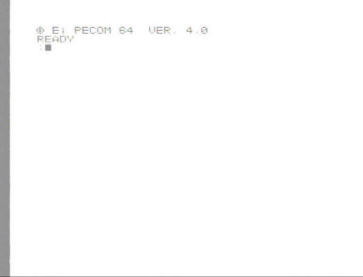Ei PECOM 64
In 1980s microcomputers became more and more popular among hobbyists
and scientists. When they became cheap enough to be used at home,
governments decided to introduce "microelectronics revolution" to
schools by teaching IT or Computer Science. However, computers were
needed for it. In western countries usually different schools used
different machines, the exception was Great Britain when they used
mostly Acorn machines. In Eastern block countries, there were
competitions to choose locally-produced machine for schools. In
Yugoslavia, they had at least 4 projects of school computers and PECOM
was one of it.
This small computer was built in Elektronska Industrija Nis factory
(Electronic Industry in Nis, currently in Serbia), known from
manufacturing radios and calculators. It is probable that the casing
comes from some calculator as it has remains of some markings. Contrary
to many computers in Eastern block, it was not based on 8080 or Z80 but
on CDP1802 processor imported from USA. This purchasing was possible as
Yugoslavia was then in a bit better market conditions with western
countries than eastern block or Soviet union. PECOM had 32kB of RAM and
16 or 32kB of ROM (PECOM64 had 32kB of ROM, PECOM32 - 16kB).
Construction was relatively simple, with power supply and color PAL
modulator built-in. It was possible then to make this computer in larger
quantities for educational demands.
Inside, it can be seen that they were manufactured as cheap as possible.
That's not about quality of components which was good. The manufacturing
process was poor - mainboard has a poor quality, soldering is made using
a low-alloy process (dry solders are quite common) and all wires are
soldered to PCB. Although machine has expansion slot on PCB, there is no
hole in case to connect something to it. 230V from power cable is going
on mainboard in thin, poorly insulated wires to the power switch in
front. Transformer is very cheap, with wires going from it instead of
connections.
| Manufacturer | Elektronska Industrija Niš | |
| Origin | Yougoslavia (now Serbia) | |
| Year of unit | 1986 | |
| Year of introduction | 1985 | |
| End of production | ?1988? | |
| CPU | RCA CDP1802 | |
| Speed | 2.813MHz | |
| RAM | 32kB | |
| ROM | 32kB (PECOM64), 16kB (PECOM32) |
|
| Colors: | 8 colours | |
| Sound: | 2-channel synthesizer | |
| OS: | BASIC | |
| Display modes: | Text: 40x24 Graphics: 240x216 by changing character set |
|
| Media: | Tape recorder | |
|
Power supply: |
||
|
Built-in 5V/-5V/12V transformer-based power supply unit. |
||
| I/O: | Monitor (composite)
output Sound output RF modulator Tape recorder Printer port (in tape recorder socket) Joystick ocnnector Unknown expansion connector inside |
|
| Possible upgrades: | ?? | |
| Accessories in collection: - none |
||
| Software accessibility: | TOSEC, dedicated sites |
My unit was bought with unknown history as "probably working, but picture not
tunable". Quickly it was found that the cable is not original and was
recently attached to prevoiusly-cut one, placing the computer in e-waste
facility in its history where cables are cut. After making the cable sit
properly in place, machine refused to start. I resoldered RAM finding
one chip broken. 4116 has been replaced by modified 4164 and machine
starts now well to BASIC.
In the bottom there is a "115/230V" marking embossed in plastic related
to some hole, not drilled. Inside, it points to mainboard. I suspect
that the case was made for some calculator and then used to make PECOM -
in the front side display could be fit and sliding switch with poor
power supply unit is characteristic for calculators. Because calculators
occupy less space than computers, voltage switch could be indeed fitted
there.
The sticker is not original. I had to re-make it. Here, have a PNG of it.
| Contents: | Starting | Recording media | Pinouts | Links |
Starting:
Recording media
Currently most programs are stored in WAV files. You have to just play it to computer and PLOAD/DLOAD it in the computer. Sometimes (especially with older sound cards) it may be needed to invert the signal, if it's needed use Audacity, CoolEdit or similar program.
Pinouts:
Tape pinout
DIN connector is also used as some simple serial interface for printer.
This pinout is taken from the document in fileland, but I don't
guarantee that it'll work as it looks like PECOM has been made in
different revisions. Better check at least ground before using.

1 - Tape input (to computer)
2 - GND
3 - Tape output from computer
4 - Printer 1
5 - Printer 2
Joystick pinout:
|
1 2 3 4 5 |
1 - GND 2..4 - NC 5 - +5V 6 - COMMON 7 - Up 8 - Right 9 - Left 10 - Down |
Links:
http://www.emma02.hobby-site.com/basic_pecom.html - BASIC reference.
http://www.emma02.hobby-site.com/pecom.html - Nice site and emulator
http://retrospec.sgn.net/users/tomcat/yu/Pecom_list.php - Games in
audio format.
https://archive.org/details/Elektronska_Industrija_Nis_PECOM_32_and_64_TOSEC_2012_04_23
- in TOSEC
https://www.grush.one.pl/?issue=komputer.1.87&article=pecom -
[POLISH] Review in old magazine. Photo of early prototype.






